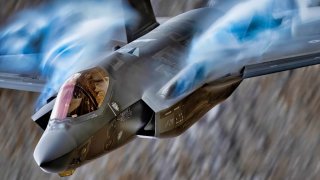The Path to an F-35 Armed with Hypersonic Missiles Is Now Clear
Lockheed Martin and CoAspire unveiled a new hypersonic missile project that could be matched with the F-35 Lightning II stealth fighter jet.
Lockheed Martin and CoAspire unveiled a new hypersonic missile project that could be matched with the F-35 Lightning II stealth fighter jet.
Emerging hypersonic munitions promise to revolutionize modern warfare and shape the outcome of future conflicts.
A New Hypersonic Program
During the Sea Air Space 2024 event this week, the two companies unveiled their Mako Multi-Mission Hypersonic Missile.
Named after the Mako shark, the munition is meant for use by the U.S. Navy and can be matched with a variety of aircraft, including the F-35 Lightning II stealth fighter jet.
According to Naval News, the munition will have multiple guidance methods, and it will be able to hold several targets at risk.
“For the U.S. Navy, this is a multi-mission, highly capable system, highly survivable, affordable, so you’re going to hold many targets at risk with one weapons system that’s ready now,” Rick Loy, senior program manager at Lockheed Martin’s Missile and Fire Control division, told Naval News.
The F-35 Lightning II is a multirole fifth-generation stealth fighter jet that comes in three versions (A, B, and C). Each iteration of the F-35 fighter jet brings a different launching capability, thus increasing the versatility of the overall platform.
Hypersonic Munitions: Benefits and Challenges
Hypersonic munitions are a key platform for the future of warfare. By traveling no slower than Mach 5 (over 3,800 miles per hour), these munitions promise to bypass enemy air defenses. For example, a hypersonic munition would be able to take out a guided-missile cruiser or destroyer before the vessel’s air defenses can shoot it down. Making matters worse, an adversary would likely be able to shoot dozens of hypersonic missiles against a target, making it more likely that the target would be destroyed.
Weapons that achieve hypersonic speeds aren’t new. Intercontinental ballistic missiles have been hitting hypersonic speeds for decades. However, there is an important difference between ballistic and hypersonic cruise missiles. The former use a parabolic trajectory to the target – they exit and then re-enter the atmosphere – while the latter use aerodynamic lift to operate and maneuver within the atmosphere.
That maneuverability makes it difficult to intercept hypersonic missiles. Ballistic missiles, although very fast, can be intercepted because air defense systems can calculate their trajectory. But the hypersonic weapons reaching modern arsenals now can maneuver in the atmosphere, making it hard to anticipate a trajectory of attack.
However, there are several challenges to these new systems. The primary one is heat. Traveling at such speeds, these munitions can create temperatures of up to 3,000° Fahrenheit. In comparison, the hottest planet in our solar system, Venus, has temperatures around 870° Fahrenheit. Such high temperatures can melt the missiles’ sensitive electronic and aviation systems.
Whichever country manages to overcome this technological hurdle first will gain a considerable military advantage over its adversaries.
About the Author
Stavros Atlamazoglou is a seasoned defense and national security journalist specializing in special operations. A Hellenic Army veteran (national service with the 575th Marine Battalion and Army HQ), he holds a BA from the Johns Hopkins University, an MA from the Johns Hopkins’ School of Advanced International Studies (SAIS). He is pursuing a J.D. at Boston College Law School. His work has been featured in Business Insider, Sandboxx, and SOFREP.


